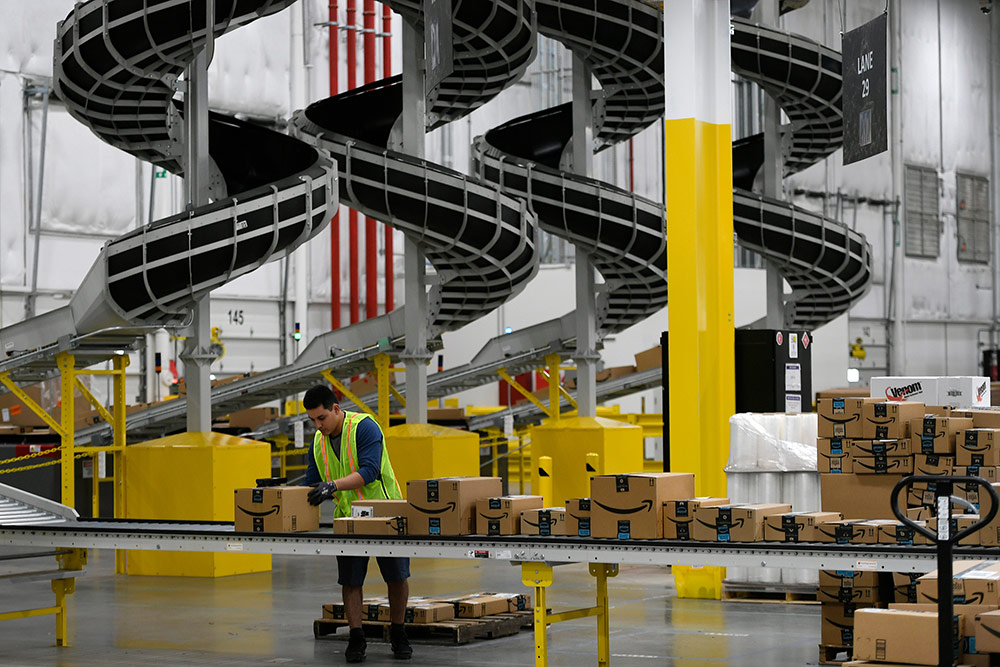
地方政府采用税收减免政策吸引亚马逊开设物流中心,然而,这家公司正在蚕食当地的经济。
新冠疫情让人们开始以新的视角来审视亚马逊对待其仓库员工的方式,这份工作不仅劳动强度大、极不稳定,如今还面临着接触致命病毒的高风险。然而,亚马逊在扩张其网络方面可谓是势不可挡,公司在全美各地百依百顺的城市和州的帮助下开设了新设施,但这些城市和州很少意识到亚马逊对当地经济的毁灭性影响。
例如在马萨诸塞州北安多佛市,亚马逊最近收到了2700万美元的公共资金,用于兴建一个新仓库。在康涅狄格州温索尔市,公司获得了880万美元的资金。亚马逊俄亥俄州格兰威路市新配送中心的不动产税获得了15年减半征收的待遇。这家电子商务巨头在印第安纳州怀特兰德和伊利诺伊州阿灵顿高地的配送中心亦拿到了纳税人税金。总的来说,亚马逊收到了来自于州和地方政府近30亿美元的补贴。这其中必然还存在其他类目的资助金。
官员们认为这些货币激励是必要的,因为此举能够为当地带来工作和投资。然而事实上,美国各地的决策者们正在花钱推动实体店的凋零,并进一步确立亚马逊作为经济各个门类守门人的角色。联邦和州官员正在重新审视亚马逊的影响力,其中最显著的事件就是7月底参议院召开的科技巨头听证会以及全国性的反垄断调查。地方政府官员亦需要注意亚马逊的影响力。
亚马逊的配送网络至少有助于提振其两个最大的利益:获取客户,以及利用这一渠道迫使其他卖家达成推广亚马逊其他业务线的强制性安排。Good Jobs First曾发现,亚马逊会战略性地在可支配收入、亚马逊Prime会员以及前往高速和机场的交通干道较为集中的地区开设仓库。这一现象实属情理之中,因为亚马逊的目标就是为那些可能购买其产品的人快速送货,这一点与税收减免或其他监管优惠政策无关。
但亚马逊还利用其仓库,向花钱聘请亚马逊通过亚马逊物流中心(FBA)处理其仓储和配送的卖家提供Prime资质以及令人垂涎的“Buy Box”,并借此从其他企业那里获取资金。由于买家购买Prime服务适用产品的可能性要高得多,因此亚马逊可以强迫企业向亚马逊付钱来承担其仓储业务,哪怕使用替代方法会更便宜、更快。
如果不使用亚马逊的物流系统,很多客户基本上永远也看不到你的产品。在上个月的参议院听证会上,亚马逊首席执行官杰夫·贝佐斯也承认采用过这一手段。
这类安排还能够让亚马逊继续提振其送货业务。去年,亚马逊50%的包裹都是由自己配送,这个数字在2017年还不到15%。亚马逊使用了自身在某一个商业领域(例如线上购物)的统治地位来侵蚀其他行业,其最终的目标便是超过联邦快递和UPS。
亚马逊迫使卖家使用其物流系统,即便此举会放缓其送货速度时亦是如此。地方自力更生研究所的隆·诺克斯和肖乌尔·萨斯曼最近解释称,亚马逊本可以在疫情期间订单激增时重启其关闭的Seller Fulfilled Prime(这种服务可以让自发货卖家有机会接触并将产品销售给亚马逊Prime会员——译者注)项目,从而向负责自身物流的卖家提供Prime资质。然而亚马逊并没有这么做,而后续的积压订单也让关键订单难以迅速到达其目的地。
对于亚马逊来说,更重要的一点在于将订单源源不断地输送至自家的储存和配送系统中。使用亚马逊物流中心的大多数公司都认为亚马逊在这项业务中很快将处于垄断地位。
尽管如此,很多地方政府官员依然对亚马逊扩张补贴一事乐此不疲,因为他们认为此举能给举步维艰的城市和城镇带来工作和收入,尤其是在疫情期间,当地企业和政府预算因疫情遭到了毁灭性打击。然而,经济政策研究所称,新仓储设施并没有给当地经济带来更多的就业增长。此举要么会阻碍其他经济活动,要么对当地经济的整体贡献不值一提。
亚马逊还削弱了传统零售业,继而影响了地方财政收入。2015年的一篇分析发现,亚马逊销售业绩所取代的零售店面原本可以贡献5.28亿美元的不动产税。这还没有计算亚马逊获得的专项税收优惠,通常以不动产税减免的形式。
通过持续资助亚马逊物流网络的扩张,各大城市和州正在一步步让当地的实体店陷入越来越落后的境地,而且也让亚马逊的垄断地位从在线购物延伸至物流、配送等领域,也就进一步扼杀了其竞争对手在这些地区出现的可能性。由于亚马逊得到了这些城市和州的保驾护航,当地希望扩张的企业将不得不通过付费的方式来接触亚马逊的客户群,而且这一费用要高于亚马逊一贯的平台使用费。
有鉴于配送网络是亚马逊的必要组件,因此即便没有纳税人的资助,公司也非常愿意设立新设施,例如它在康尼狄格州丹布利、德州福德本德郡新开设的设施。地方官员必须收紧钱袋,将其有限的资源用于提供关键服务,并扶持当地受新冠疫情严重影响的小企业,而不是将其用来补贴亚马逊。(财富中文网)
帕特·加罗法洛是美国经济自由项目国家与地方政策业务主任,也是《亿万美元的无效投资:政客是如何让企业和权贵偷走我们的资金和工作》一书的作者。
作者:Pat Garofale
译者:Feb
地方政府采用税收减免政策吸引亚马逊开设物流中心,然而,这家公司正在蚕食当地的经济。
新冠疫情让人们开始以新的视角来审视亚马逊对待其仓库员工的方式,这份工作不仅劳动强度大、极不稳定,如今还面临着接触致命病毒的高风险。然而,亚马逊在扩张其网络方面可谓是势不可挡,公司在全美各地百依百顺的城市和州的帮助下开设了新设施,但这些城市和州很少意识到亚马逊对当地经济的毁灭性影响。
例如在马萨诸塞州北安多佛市,亚马逊最近收到了2700万美元的公共资金,用于兴建一个新仓库。在康涅狄格州温索尔市,公司获得了880万美元的资金。亚马逊俄亥俄州格兰威路市新配送中心的不动产税获得了15年减半征收的待遇。这家电子商务巨头在印第安纳州怀特兰德和伊利诺伊州阿灵顿高地的配送中心亦拿到了纳税人税金。总的来说,亚马逊收到了来自于州和地方政府近30亿美元的补贴。这其中必然还存在其他类目的资助金。
官员们认为这些货币激励是必要的,因为此举能够为当地带来工作和投资。然而事实上,美国各地的决策者们正在花钱推动实体店的凋零,并进一步确立亚马逊作为经济各个门类守门人的角色。联邦和州官员正在重新审视亚马逊的影响力,其中最显著的事件就是7月底参议院召开的科技巨头听证会以及全国性的反垄断调查。地方政府官员亦需要注意亚马逊的影响力。
亚马逊的配送网络至少有助于提振其两个最大的利益:获取客户,以及利用这一渠道迫使其他卖家达成推广亚马逊其他业务线的强制性安排。Good Jobs First曾发现,亚马逊会战略性地在可支配收入、亚马逊Prime会员以及前往高速和机场的交通干道较为集中的地区开设仓库。这一现象实属情理之中,因为亚马逊的目标就是为那些可能购买其产品的人快速送货,这一点与税收减免或其他监管优惠政策无关。
但亚马逊还利用其仓库,向花钱聘请亚马逊通过亚马逊物流中心(FBA)处理其仓储和配送的卖家提供Prime资质以及令人垂涎的“Buy Box”,并借此从其他企业那里获取资金。由于买家购买Prime服务适用产品的可能性要高得多,因此亚马逊可以强迫企业向亚马逊付钱来承担其仓储业务,哪怕使用替代方法会更便宜、更快。
如果不使用亚马逊的物流系统,很多客户基本上永远也看不到你的产品。在上个月的参议院听证会上,亚马逊首席执行官杰夫·贝佐斯也承认采用过这一手段。
这类安排还能够让亚马逊继续提振其送货业务。去年,亚马逊50%的包裹都是由自己配送,这个数字在2017年还不到15%。亚马逊使用了自身在某一个商业领域(例如线上购物)的统治地位来侵蚀其他行业,其最终的目标便是超过联邦快递和UPS。
亚马逊迫使卖家使用其物流系统,即便此举会放缓其送货速度时亦是如此。地方自力更生研究所的隆·诺克斯和肖乌尔·萨斯曼最近解释称,亚马逊本可以在疫情期间订单激增时重启其关闭的Seller Fulfilled Prime(这种服务可以让自发货卖家有机会接触并将产品销售给亚马逊Prime会员——译者注)项目,从而向负责自身物流的卖家提供Prime资质。然而亚马逊并没有这么做,而后续的积压订单也让关键订单难以迅速到达其目的地。
对于亚马逊来说,更重要的一点在于将订单源源不断地输送至自家的储存和配送系统中。使用亚马逊物流中心的大多数公司都认为亚马逊在这项业务中很快将处于垄断地位。
尽管如此,很多地方政府官员依然对亚马逊扩张补贴一事乐此不疲,因为他们认为此举能给举步维艰的城市和城镇带来工作和收入,尤其是在疫情期间,当地企业和政府预算因疫情遭到了毁灭性打击。然而,经济政策研究所称,新仓储设施并没有给当地经济带来更多的就业增长。此举要么会阻碍其他经济活动,要么对当地经济的整体贡献不值一提。
亚马逊还削弱了传统零售业,继而影响了地方财政收入。2015年的一篇分析发现,亚马逊销售业绩所取代的零售店面原本可以贡献5.28亿美元的不动产税。这还没有计算亚马逊获得的专项税收优惠,通常以不动产税减免的形式。
通过持续资助亚马逊物流网络的扩张,各大城市和州正在一步步让当地的实体店陷入越来越落后的境地,而且也让亚马逊的垄断地位从在线购物延伸至物流、配送等领域,也就进一步扼杀了其竞争对手在这些地区出现的可能性。由于亚马逊得到了这些城市和州的保驾护航,当地希望扩张的企业将不得不通过付费的方式来接触亚马逊的客户群,而且这一费用要高于亚马逊一贯的平台使用费。
有鉴于配送网络是亚马逊的必要组件,因此即便没有纳税人的资助,公司也非常愿意设立新设施,例如它在康尼狄格州丹布利、德州福德本德郡新开设的设施。地方官员必须收紧钱袋,将其有限的资源用于提供关键服务,并扶持当地受新冠疫情严重影响的小企业,而不是将其用来补贴亚马逊。(财富中文网)
帕特·加罗法洛是美国经济自由项目国家与地方政策业务主任,也是《亿万美元的无效投资:政客是如何让企业和权贵偷走我们的资金和工作》一书的作者。
作者:Pat Garofale
译者:Feb
The coronavirus pandemic has brought new scrutiny to the way in which Amazon treats its warehouse workers, whose exhausting, precarious positions now come with a decent chance they’ll be exposed to a deadly virus. And yet, Amazon is going gangbusters to expand its network, opening new facilities all across the country with the aid of compliant cities and states and little recognition of Amazon’s devastating impact on local economies.
In North Andover, Mass., for instance, Amazon recently received $27 million in public funding to build a new warehouse. In Windsor, Conn., it was $8.8 million. The property taxes for a new Amazon distribution center in Glenwillow, Ohio, will be reduced by nearly half for 15 years. And the e-commerce giant is receiving taxpayer dollars for distribution facilities in Whiteland, Ind., and Arlington Heights, Ill., too. Overall, Amazon has received nearly $3 billion in subsidies from state and local governments. There are surely other handouts in the works.
Officials justify these monetary favors as necessary for bringing jobs and investment to a local area. But in truth, policymakers are funding the demise of Main Streets across America and further entrenching Amazon as a gatekeeper across wide swathes of the economy. Federal and state officials are looking anew at Amazon’s power, most prominently through Congress’ big tech hearing in late July and state-level antitrust investigations. Local officials need to pay attention to Amazon’s power, too.
Amazon’s distribution network promotes at least two significant interests for the company: accessing customers and using that access to force other sellers into coercive arrangements that promote Amazon’s other lines of business. As Good Jobs First has found, Amazon strategically places warehouses where there is a concentration of disposable income, Amazon Prime subscribers, and easy access to highways and airports. That makes sense, since Amazon’s aim is to get stuff to people who are likely to buy things from it faster, regardless of any sort of tax incentive or other regulatory favor.
But Amazon also leverages its warehouses to extract funds from other businesses by giving Prime Eligibility and the coveted “Buy Box” to sellers who pay Amazon to handle their storage and distribution through Fulfillment by Amazon, or FBA. Because buyers are far more likely to buy items that are Prime eligible, Amazon can coerce businesses into paying Amazon to handle their warehousing, even if it would be cheaper and faster to use alternative methods.
Don’t use Amazon’s fulfillment system, and loads of customers simply never see your product. During last month’s congressional hearing, Amazon CEO Jeff Bezos admitted to employing this tactic.
This sort of arrangement also allows the company to continue to bolster its shipping operation. Last year, Amazon delivered nearly 50% of its own packages, compared to less than 15% in 2017. Dominance in one area of commerce—online shopping—is being used by Amazon to make inroads into others, with the eventual aim of toppling FedEx and UPS.
Amazon pushes sellers into using its logistics system even when doing so slows down deliveries. As Ron Knox and Shaoul Sussman of the Institute for Local Self-Reliance recently explained, Amazon could have reopened its shuttered Seller Fulfilled Prime program when orders spiked during the pandemic, granting Prime eligibility to sellers who handle their own logistics. It didn’t, and the subsequent backlog kept critical orders from reaching their destination quickly.
To Amazon, it was simply more important to keep funneling orders into its own storage and delivery system. Most companies in the fulfillment space think Amazon is well on its way to monopolizing the business.
Despite all this, many local officials are still keen on subsidizing Amazon’s expansion because they believe it will bring jobs and revenue to struggling cities and towns, especially during a pandemic that has devastated local businesses and government budgets. But according to the Economic Policy Institute, new warehouses don’t bring wider employment growth to a local economy. They either blunt other economic activity or have too small of an overall impact to even measure.
Amazon also decimates local budgets through its effect on traditional retail. A 2015 analysis found that Amazon sales displaced retail outlets that would have paid $528 million in property taxes. And that’s before getting into the specific tax benefits given to Amazon, which usually come in the form of property tax reductions.
By continually funding the expansion of Amazon’s fulfillment network, cities and states are ensuring that their own brick-and-mortar stores fall ever further behind, and that Amazon’s monopoly power extends from online shopping to logistics, shipping, and beyond, making the emergence of a competitor in any of those areas ever more unlikely. They’re guaranteeing that local businesses hoping to expand will be forced to pay tolls to access Amazon’s customer base, above and beyond the usual fees Amazon extracts from users of its platform.
Since Amazon needs its distribution network, it is perfectly willing to open new facilities without taxpayer largesse—as it reportedly did in Danbury, Conn., and Fort Bend County, Texas. Rather than subsidizing Amazon, local officials must close the spigot, and focus their limited resources on providing key services and promoting small, local businesses that are threatened by the COVID-19 pandemic.
Pat Garofalo is director of state and local policy at the American Economic Liberties Project and author of The Billionaire Boondoggle: How Our Politicians Let Corporations and Bigwigs Steal Our Money and Jobs.






